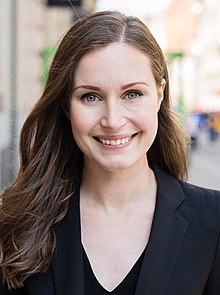Prime Minister of Finland
| Prime Minister of Finland | |
|---|---|
| Suomen pääministeri Finlands statsminister | |
 Official Seal of the Prime Minister | |
 State Flag of Finland | |
since 10 December 2019 | |
| Style | Her Excellency |
| Member of | Cabinet of Finland European Council |
| Residence | Kesäranta in Helsinki, Finland |
| Appointer | President of the Republic of Finland |
| Term length | No fixed length Duration of the parliamentary convocation, coalition or upon resignation and removal |
| Precursor | Vice-Chairman of the Economic Division of the Senate of Finland |
| Inaugural holder | Pehr Evind Svinhufvud |
| Formation | 27 November 1917 |
| Salary | € 12,173 monthly[1] |
| Website | valtioneuvosto |
 |
|---|
The prime minister of Finland (Template:Lang-fi, literally main minister or head minister, Template:Lang-sv, literally minister of state) is the leader of the Finnish Government. The Prime Minister is Finland's head of government and is formally appointed by the President of Finland. Finland's first Prime Minister was Pehr Evind Svinhufvud (also later known as the 3rd President of the Republic of Finland), who was appointed to the post on 27 November 1917.
The incumbent Prime Minister is Sanna Marin of the Social Democratic Party. Marin was sworn in on 10 December 2019 and at 34, she became the world's youngest serving state leader and the youngest Prime Minister in Finland's history.[2]
History
In 1918, the Senate of Finland was transformed into the Government of Finland, and the position of Vice-Chairman of the Economic Division was transformed into that of the prime minister. Kesäranta, located in the westerly Meilahti subdivision of Helsinki, has been the official residence of the prime minister of Finland since 1919.
During its independence, declared in 1917, Finland has had 72 cabinets.[3] The longest lasting have been the two cabinets of prime minister Paavo Lipponen (Lipponen I and Lipponen II), both lasting the entire parliamentary term, or 1,464 days.
Appointment
The prime minister's appointment follows the parliamentary election, which are scheduled to be held once every four years.
Under the provisions of the Constitution of Finland, the president nominates a prime minister after the parties in the parliament have negotiated the distribution of seats in the new cabinet and the government's programme. The parliament must ratify the nominated prime minister with an absolute majority in a confidence vote without other candidates. If the nominee doesn't receive sufficient support, a new round of negotiations and a second nomination by the President follows. If the second nominee also fails to gain an absolute majority, a third vote is held, in which any member of parliament can nominate a candidate; in this round a plurality is sufficient for election.
The above procedure was first used to elect Anneli Jäätteenmäki to the premiership in 2003. Previously it was assumed that the president would nominate the candidate who, in a third round of voting, would have gained a relative majority, this usually being the leader of the party with the largest seat share in parliament. Before the 2000 constitution was enacted, full formal powers to appoint the prime minister and the rest of the government had been the privilege of the president, who was free to diverge from parliamentary principles, although the ministers appointed had to have the confidence of the parliament.
Formally, the prime minister nominates the remaining members of the government, who are then, with the consent of Parliament, appointed by the president. In practice, the seats are divided between parties during the negotiations to form the government, so that the prime minister candidate must take into account the opinions of the participating parties and cannot nominate or remove whoever they wish.
Salary and benefits
The prime minister's salary is €12,173 per month.[1] In addition, the prime minister receives half of the parliamentary salary. The full parliamentary salary is, as of 1 May 2011, at least €6,335 a month, so the Finnish prime minister receives at least €14,842 per month in total. The salary is subject to income tax.
The prime minister is entitled to a 30-day leave (holiday) during each calendar year. The maintenance, staff and services of Kesäranta, the official residence, is paid for by the government.
The prime minister has transportation and security services at their disposal at all times.
Living former prime ministers
-
Esko Aho
20 May 1954, served 1991–1995 -
Paavo Lipponen
23 April 1941, served 1995–2003 -
Anneli Jäätteenmäki
11 February 1955, served 2003 -
Matti Vanhanen
4 November 1955, served 2003–2010 -
Mari Kiviniemi
27 September 1968, served 2010–2011 -
Jyrki Katainen
14 October 1971, served 2011–2014 -
Alexander Stubb
1 April 1968, served 2014–2015 -
Juha Sipilä
25 April 1961, served 2015–2019 -
Antti Rinne
3 November 1962, served 2019
The most recent death of a former prime minister of Finland is that of Mauno Koivisto (1979–1982) on 12 May 2017.
See also
References
- ^ a b "Ministerial pay and allowances". Valtioneuvosto.
- ^ Guardian Staff and Agencies. "Finland anoints Sanna Marin, 34, as world's youngest-serving prime minister". The Guardian. Retrieved 9 December 2019.
- ^ Finnish Council of State. "The Cabinet in Office". Finnish Council of State. Archived from the original on 13 November 2010. Retrieved 23 June 2010.












